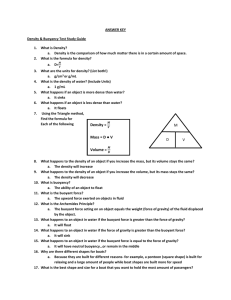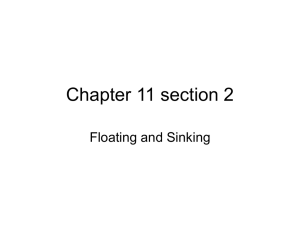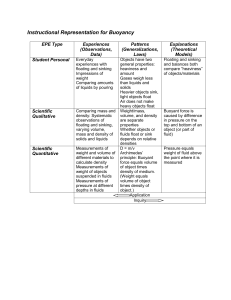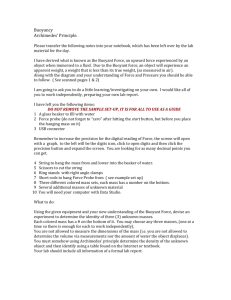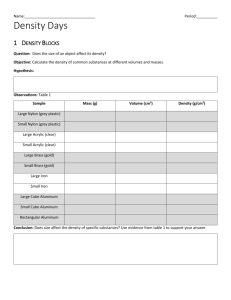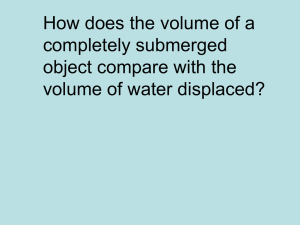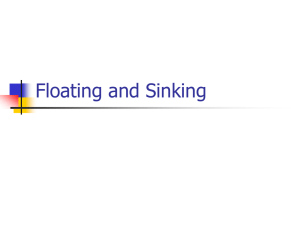buoyancyandshape
advertisement
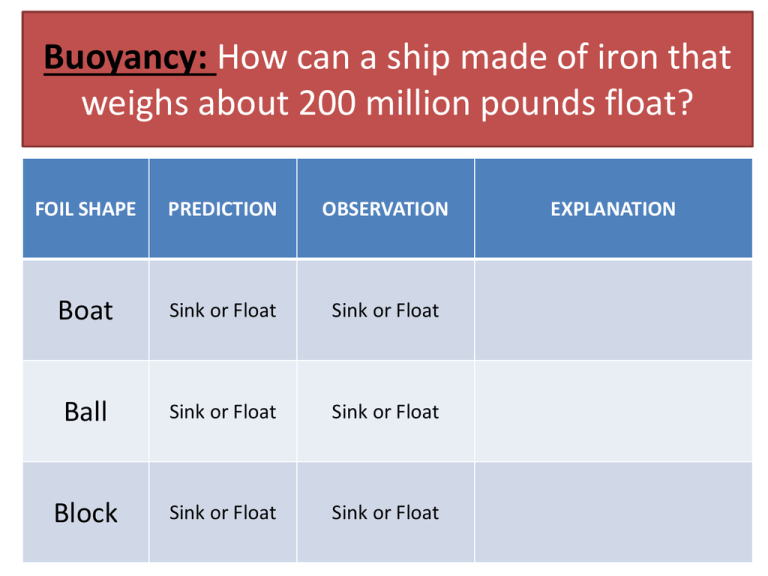
Buoyancy: How can a ship made of iron that weighs about 200 million pounds float? FOIL SHAPE PREDICTION OBSERVATION Boat Sink or Float Sink or Float Ball Sink or Float Sink or Float Block Sink or Float Sink or Float EXPLANATION Aluminum Foil Boats • Objective: To design/build two different aluminum foil boats that will hold as many pennies as possible without sinking. • Procedure 1. Obtain two 20cmx20cm pieces of aluminum foil. 2. Build your boats. 3. Test them by adding pennies until they sink. 4. Dry the pennies off and return them. 5. Which boat in the class won? Why? Shape and density determine if something will float. Buoyant Force: When an object displaces water the water pushes back on it. What happens to the weight of an object when placed in water? 4 Intro to Forces: PHET Sim • Force: a push or a pull (unit: Newtons) • If Force are balanced an object will not move or change its motion! • Unbalanced forces lead to changes in motion. https://phet.colorado.edu/en/simulation/forces-and-motion-basics These four cubes are resting on a table. Each cube is made of a different material. Rank these cubes in terms of mass, weight and volume from largest to smallest. (a) (b) (c) (d) Mass Highest to [1] Lowest [2] [3] [4] or Not enough information Weight Highest [1] to Lowest [2] [3] [4] or Not enough information Volume Highest [1] to Lowest [2] [3] [4] or Not enough information These four cubes are resting on a frictionless surface. Each cube is pushed and pulled by different forces. Rank each object from the highest to lowest net force Force arrows show direction only, they are not drawn to scale. 70N 100N 50N 100N 35N 65N 80N 90N 10kg 10kg 10kg 10kg (a) (b) (c) (d) [1] Highest [2] [3] [4] Lowest Explain: These four cubes are resting on a frictionless surface. Each cube is pushed and pulled by different forces. Rank each object from the highest to lowest net force Force arrows show direction only, they are not drawn to scale. 40N 30N 10kg 10N (a) [1] Highest [2] 75N 65N 60N 10kg 10kg (b) (c) [3] [4] Lowest 85N 10N 90N 10kg (d) Explain: Buoyant Force (upward push of water) 1. If Weight is greater than Buoyant Force an object sinks. 2. If Buoyant Force is greater than weight the object rises and then floats. 3. When Buoyant Force equals weight the object floats or suspends. Weight Force (heaviness of object) Which is greater: the Weight or Buoyant Force? 10 Floating: Buoyant Force = Weight If a 100N boat is floating the water must be pushing on it with a force of 100N F = 100N F = 100N If we add weight (50N) to the boat it will sink down deeper and the buoyant force will increase. F = 150N F = 150N Buoyant Force (upward push of water) Archimedes Principle: Buoyant force is equal to the weight of the liquid displaced . The more water an object displaces the more buoyant force pushing on it. This is why a block of aluminum sinks but an aluminum foil boat floats. Weight Force (heaviness of object) Shape is important! If you were to hold a basketball under water it will push back very hard and would fly upwards if your were to release it. Buoyant Force > Weight If you were to hold a basketball under water it will push back very hard and would fly upwards if your were to release it. Buoyant Force > Weight When floating the buoyant force on ball equals its weight. Why is it easier to lift a person in water? Weight (force) Lift (force) 50N 50N Why is it easier to lift a person in water? The water helps you! Weight (force) Lift (force) 50N Weight (force) 50N Buoyant (force) Lift (force) Concrete Boats • Heavy iron ships can float because they are shaped to displace a large amount of water and being hollow and filled with air reduces their overall density. • Its easier to pick someone up in water because the water helps you (buoyant force).
